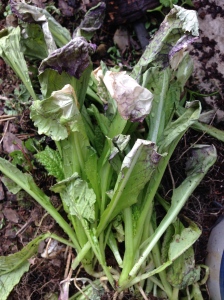Yesterday the sun came out and melted the dumping of snow we got last Friday, which followed a multi-day Polar Vortex that brought temperatures down to 0 degrees with windchills around -25.
As I ventured out back to see what survived, I was reminded of a story Eliot Coleman tells in Four-Season Harvest. I’m quoting it at length because a) I love it, and b) because it remains an inspiration for the season extension work we do at Over the Fence, and the seasonal eating we do in our home.
During [our] January trip across France, we had an experience that emphasized the point. We were visiting the Jardin des Plantes in Montpelier, one of the oldest botanical gardens in France. Like many such venerable institutions, it was showing its age. Some of the walls were beginning to crumble and panes were missing in unused glasshouses. But we were not there for the architecture. We had come to see the “non-existent” vegetables. When we had called ahead to learn the winter hours and had inquired about the vegetable garden, the nice Frenchman on duty told us not to waste our time because the vegetable garden was “non-existent” in the winter. Ah, well, we had heard that song before. “There is nothing in the garden” is usually synonymous with “it doesn’t look nice like it did last summer.”
The vegetable garden at the Jardin des Plants occupies one quarter of a parterre in front of the orangerie. Admittedly it probably did look nicer during the summer, but it was just what we wanted to find in January. Despite the disclaimers of the garden staff, this abandoned Zone 9 garden, which had probably seen no care since October, still contained ready-to-pick crops of chard, salsify and scorzonera, six different types of lettuces, radicchio, sorrel, mustard greens, turnips and turnip greens, kale, cabbages, winter radish, red and green scallion, leeks, and spinach. If that garden were in our backyard, we would have considered it a source of fresh main course and salad vegetables for the rest of the winter. It was a cornucopian example of a garden truth we have long notes–if you just look around in a post-season garden, you will almost always find something to eat.
After you read this post, head out to your winter garden and see if you can score some greens for your next meal. Here’s what I found yesterday, when the high got up to 55.

Not too surprisingly, Tatsoi did great.

Lacinato Kale is also tough and super cold hardy.

The few heads of Napa Cabbage still hanging around lived to see another day.

And even these tiny heads of Romaine (which I left as a test) were insulated enough to survive.

The Arugula I didn’t chop down in January still tastes amazing. Hoping for a small bounce back crop from these plants as temperatures return to the 30 and 40s.

The Swiss Chard was glowing.

A few heads of Raddichio are waiting for their turn at the table.

This Pac Choi was in the high tunnel, under a second cover, but managed to get burned. Need to investigate that.

Another cold weather winner, Giant Red Mustard, is ready for a growth spurt to welcome back Persephone.

As are these baby Red Russian Kale. Though they look like they could use a drink of water. The high tunnel can get a little dry this time of year. Might try to catch some of the rain coming this week and move it in before the overnight temperatures dip down again.

Our cold frame-within the high tunnel started seedlings are patiently awaiting transplant. In this box, Pac Choi, Red Russian Kale, and Tatsoi…

…and here, spinach….

…which looks amazing up close, and tastes like good health.

The biggest Polar Vortex surprise by far is that one of the chickens started laying! I suspect Hermione or Ginny since their combs and waddles are the most fully formed. Won’t be much longer until we’re (happily) drowning in eggs again!

As a reward, the girls got to come under one of the low tunnels for a snack and dust bath.

And the humans all enjoyed post-Vortex salads with dinner!
























